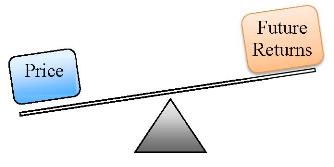When the price of any investment declines, two things are certain: 1) its historical returns (over every period) are worse than they were before the price decline, and 2) its future returns (over every period) are better than they were before.
This is an unchangeable law of finance and is true in every case with one important exception: the case when a stock’s or a bond’s price declines in anticipation of bankruptcy. But, since asset classes don’t go bankrupt, this lone exception doesn’t apply to markets.
Consider a bond bought at par ($1,000) by Ms. Low that has a 5% coupon (annual interest rate) and matures in two years at par. The annual total return over a two-year holding period will simply be 5% as the coupon will be paid each year and there will be no gain or loss since the bond will mature at the same price as was paid at issuance. But what if after one year, Mr. High buys that same bond at $1,010 knowing that he’ll receive $50 a year in interest as well as $1,000 at maturity (now 1 year away)? Because of this price increase, Mr. High now expects to make less than 5% on the bond. He will gain the $50 of interest, but receive $10 less than his purchase price when the bond matures for a net return of $40. This return of $40 over one year represents an expected return of 3.96% on his $1,010 investment.
So Mr. High expects to make 3.96% on the same bond that Ms. Low expected to make 5%. The price went up in the first year sending future returns down. If Ms. Low is the one who sold her bond after a year, she unexpectedly made 6% (5% interest plus 1% price gain) on her $1,000 investment. The price rise sent the historical return up for Ms. Low. One can think of price increases as pulling future returns forward (to Ms. Low’s benefit) and thus leaving less to be realized later (to Mr. High’s detriment). A drop in price would have the opposite effect, driving historical returns down and future returns up.

This concept may be easier to grasp with bonds (with fixed maturities) than with stocks, but the same dynamic is at work with every asset class. The stock market’s value at any date in the future is unknown, but whatever that future value may prove to be, its return from here to there will be greater after a price drop and less after a price rise. This is the price-return fulcrum – a teeter-totter, if you will. As price falls, future return rises, and vice versa. Rational long-term investors will naturally favor any asset class less after its price has risen and more after it has fallen. Unfortunately, emotions tend to pull most investors in the opposite direction, increasing their enthusiasm for assets that have risen in price and engendering disdain for assets that have fallen in price. Our recognition of this disconnect between emotions and the price-return fulcrum is one of the reasons an objective disciplined process is a pillar of our investment philosophy.